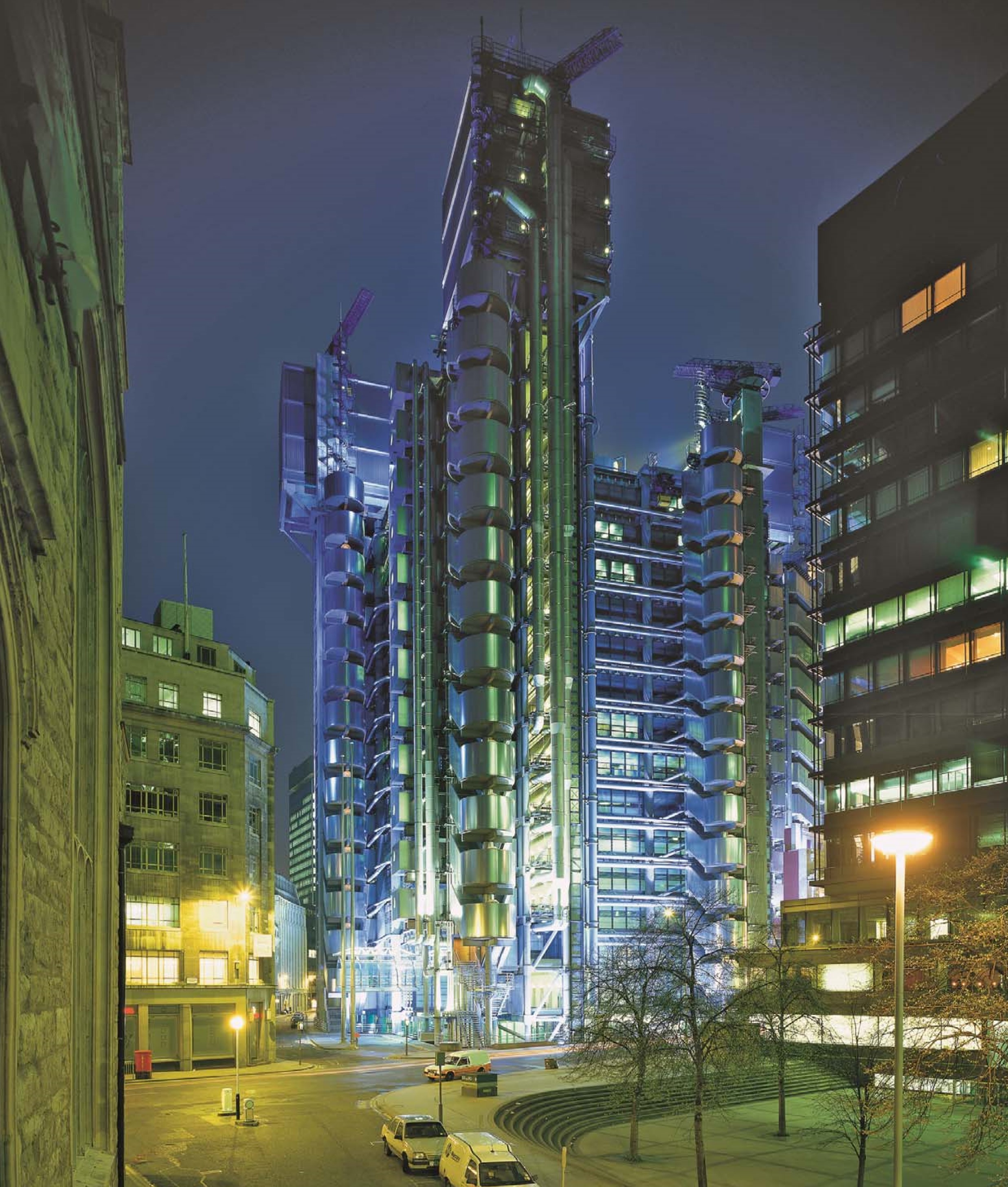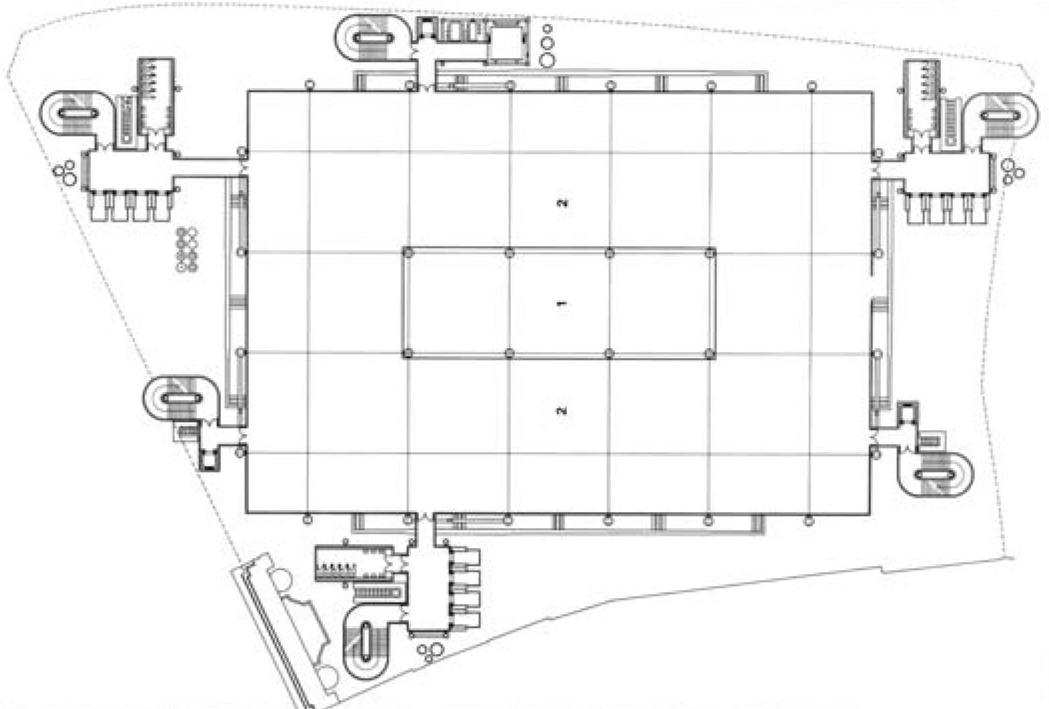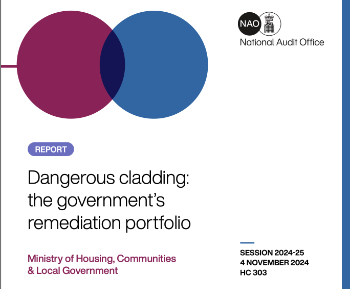Lloyd's of London
Contents |
[edit] Introduction
Lloyd’s of London, designed by Richard Rogers, is one of the most iconic buildings in London and a leading example of the ‘high-tech’ architectural style that combines both industrial and futuristic aesthetics. Historic England described it as being ‘universally recognised as one of the key buildings of the modern epoch.’
Situated at 1 Lime Street in the City of London, the Lloyd’s Building, home to insurance company Lloyd’s of London, was officially opened in 1986 after a construction period of 8 years. It cost approximately £75,000,000 to build.
[edit] History
Lloyd’s of London had occupied a nearby site on Leadenhall Street since 1928, moving to Lime Street in 1958 as a means of expanding with the market. Towards the end of the 1970s there was a need to expand further and so the decision was taken to purchase the current site.
At this time, Norman Foster and Richard Rogers were celebrated figures of British architecture, and had stated their intentions to re-energise the Modern Movement with what became known as ‘high tech’ due to its abundance of steel and glass. Public money was in short supply for the kind of flagship building projects they had in mind, so increasingly they looked to the private sector.
One of the pioneering examples of the high tech style was the Centre Pompidou in Paris, which had been designed by Richard Rogers and Renzo Piano. This building was unique in that the services, such as staircases, lifts, drainage and water pipes, were on external display as opposed to being concealed and taking up space inside the building.
When Lloyd’s commissioned Richard Rogers to design their new building, the brief was to create something that would be flexible and hence facilitate their changing needs. They also wanted a building that would provide for its needs well into the next century. It was also imperative that they could continue their operations unhindered during the rebuilding operation, which involved the demolition of the existing 1928 building. The competition for a new building was won on the basis not of an architectural proposal but of a strategy for the future of this key City institution.
[edit] Design
Richard Rogers Partnership (RRP, now Rogers Stirk Harbour + Partners RSHP) proposed a building in which the dealing room could expand or contract according to the needs of the market, by means of a series of galleries around a central space. To maximise space, services were banished to the perimeter. As the architectural form of the building evolved, particular attention was paid to its impact on the surrounding area, especially the listed 19th century Leadenhall Market. As a result, Lloyd’s became a complex grouping of towers, almost Gothic in feeling – an effect enhanced by the height of the external plant-room towers.
The building consists of three towers, each with their own service tower, which surround a central 60-metre high atrium that houses the main Underwriting Room and is naturally lit by a barrel-vaulted glass roof that took its inspiration from Joseph Paxman’s Crystal Palace. The building features 12 glass lifts that were the first of their kind in the UK.
As with the Centre Pompidou, the services were located externally, freeing up the interior of the building so that it could remain flexible, each floor capable of being altered by the addition or removal of partitions. This style was dubbed ‘bowellism’, based on the idea that the greatest amount of free floor space should be maintained.
Criss-crossing the atrium are a series of escalators intended to create a sense of the circulation between the floors. The cranes were left on top of the building, much the same as for old cathedrals that were intended to be modified and built to an ever grander scale.
When it was completed by the contractor in 1986 it stood at 88 metres (289 ft) to the roof, and contained 14 floors. With the cranes the overall height reaches 95.1 metres (312 ft).
[edit] Today
Whilst initially provoking controversy due to its striking contrast with the surrounding area, Lloyd’s is today seen as one of the great architectural achievements of the 1980s, one of the buildings which confirmed the Rogers' position in the front rank of international architects. In 2011, it became the youngest building ever to receive Grade I listed status.
It has emerged as one of the greatest modern British buildings, one which balances technical efficiency with architectural expressiveness to produce an effect that is highly-romantic and judged a very positive addition to the London skyline.
In July 2013, it was sold to the Chinese company Ping An Insurance for a reported £260 million.
It is normally closed to the public, but does open occasionally for tours, most commonly during the annual Open House London event.
[edit] Project information
- Place: London, UK
- Date: 1978 - 1986
- Client: Lloyd’s of London
- Cost: £75 million
- Area: 55,000 m²
- Structural and Services Engineer: Ove Arup & Partners
- Quantity Surveyor: Monk Dunstone Associates
- Lighting Consultant: Friedrich Wagner of Lichttechnische Planung
- Main Contractor: Bovis Construction Ltd
- Architect: Richard Rogers Partnership
[edit] Awards:
2011
- Grade I listed by English Heritage
1988
- RIBA Regional Award
- PA Award for Innovation in Building Design and Construction
- Eternit 8th International Prize for Architecture (Special Mention)
1987
- Financial Times ‘Architecture at Work’ Award
- Civic Trust Award
- Concrete Society Commendation
[edit] Related articles on Designing Buildings Wiki
- 7 Engineering Wonders of the world.
- 9 of the world’s most impressive structures.
- Bank of China Tower.
- BBVA Bancomer headquarters.
- BT Tower.
- Building of the week series.
- Centre Building at LSE shortlisted for RIBA award.
- City Hall, London.
- Fuji TV Building, Tokyo.
- Guggenheim Museum, Bilbao.
- Habitat 67.
- Leadenhall building.
- One Park Taipei.
- Metabolism.
- Millennium Dome.
- NatWest Tower.
- Richard Rogers.
- Skyfarm.
- Tallest buildings in the world.
- The Gherkin.
- The Shard.
[edit] External references
- Lloyd's - The Lloyd's Building
- RSHP - Job sheet
Featured articles and news
London Build: A festival of construction
Co-located with the London Build Fire & Security Expo.
Tasked with locating groups of 10,000 homes with opportunity.
Delivering radical reform in the UK energy market
What are the benefits, barriers and underlying principles.
Information Management Initiative IMI
Building sector-transforming capabilities in emerging technologies.
Recent study of UK households reveals chilling home truths
Poor insulation, EPC knowledge and lack of understanding as to what retrofit might offer.
Embodied Carbon in the Built Environment
Overview, regulations, detail calculations and much more.
Why the construction sector must embrace workplace mental health support
Let’s talk; more importantly now, than ever.
Refurbishment for net zero; the BSRIA white paper
The everyday practice of tackling energy efficiency, fabric first, ventilation, air quality, and occupant wellbeing.
Ensuring the trustworthiness of AI systems
A key growth area, including impacts for construction.
Foundations for the Future: A new model for social housing
To create a social housing pipeline, that reduces the need for continuous government funding.
Mutual Investment Models or MIMs
PPP or PFI, enhanced for public interest by the Welsh Government.
Stress Awareness Week ends but employer legal duties continue.
A call to follow the five Rs for the business and for the staff.
Key points and relevance to construction of meeting, due to reconvene.
Cladding remediation programmes, transparency and target date.
National Audit Office issue report on cladding remediation.
HBPT and BEAMS Jubilees. Book review.
























